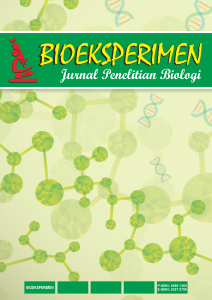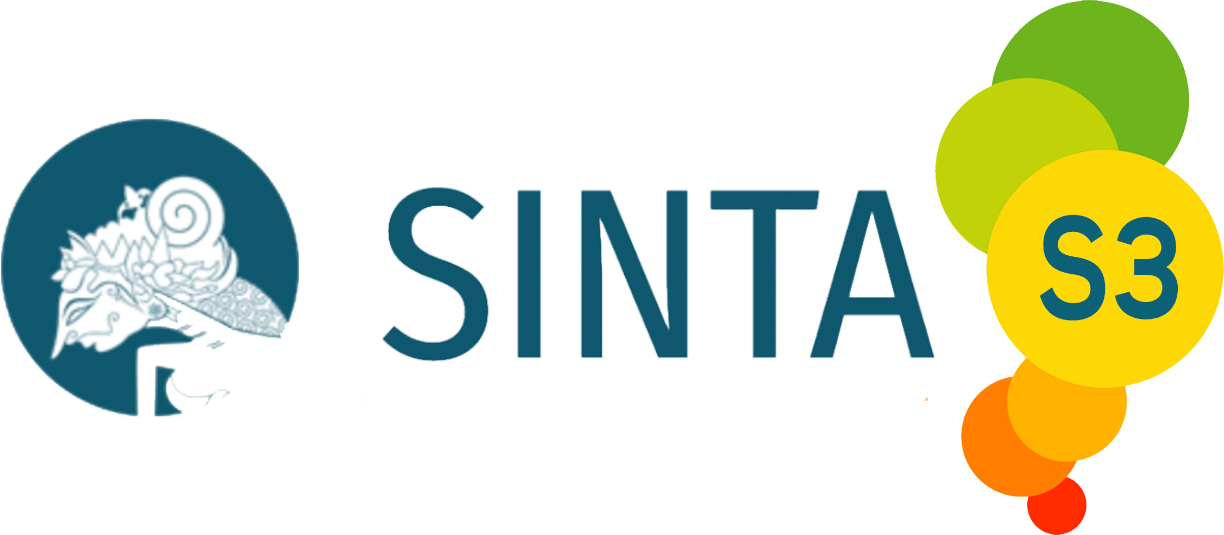Diversity of Pollinator Insects in Anagro Garden, Bengkulu City, Indonesia
DOI:
https://doi.org/10.23917/bioeksperimen.v11i2.12305Abstract
Pollinator insects are considered beneficial organisms due to their essential role in plant pollination, supporting both ecological stability and agricultural productivity. However, land-use change and pesticide application may reduce pollinator diversity, making it necessary to identify existing species and assess their diversity as indicators of ecosystem health. This study aimed to identify the species and assess the diversity of pollinator insects in Anagro Garden, Bengkulu City. Field research was conducted from January to March 2025 using an exploratory survey method combined with direct observation. Sampling was carried out across multiple points within the garden. The results showed that pollinator insects observed in this area belonged to four insect orders. The calculated Shannon-Wiener Diversity Index (H′) was 1.317, indicating a moderate level of species diversity. The Dominance Index (D) was 0.283, showing that no single order overwhelmingly dominated the assemblage. The Evenness Index (E) was 0.950, reflecting a high level of evenness and very uniform distribution of individuals among species. These findings suggest that although species abundances vary, the pollinator community remains balanced. The moderate diversity level indicates that the ecosystem quality in Anagro Garden is still fairly goodHowever, the study underscores the need for ongoing monitoring and habitat management to enhance pollinator diversity and maintain ecological resilience, particularly in semi-urban agroecosystems like those found in Bengkulu City.
Downloads
References
Choi, S.-W., & Jung, C. (2015). Diversity of insect pollinators in different agricultural crops and wild flowering plants in Korea: Literature review. Journal of Apiculture, 30(3), 191. https://doi.org/10.17519/apiculture.2015.09.30.3.191
Crall, J. D., Brokaw, J., Gagliardi, S. F., Mendenhall, C. D., Pierce, N. E., & Combes, S. A. (2020). Wind drives temporal variation in pollinator visitation in a fragmented tropical forest. Biology Letters, 16(4). https://doi.org/10.1098/rsbl.2020.0103
Dainese, M., Martin, E. A., Aizen, M. A., Albrecht, M., et al. (2019). A global synthesis reveals biodiversity-mediated benefits for crop production. Science Advances, 5(10), eaax0121. https://doi.org/10.1126/sciadv.aax0121
Daniels, B., Jedamski, J., Ottermanns, R., & Ross-Nickoll, M. (2020). A “plan bee” for cities: Pollinator diversity and plant–pollinator interactions in urban gardens. Plos One, 15(7), e0235492. https://doi.org/10.1371/journal.pone.0235492
Eeraerts, M., Smagghe, G., & Meeus, I. (2019). Pollinator diversity, floral resources and semi-natural habitat, instead of honey bees and intensive agriculture, enhance pollination service to sweet cherry. Agriculture, Ecosystems & Environment, 284, 106-586. https://doi.org/10.1016/j.agee.2019.106586
Febriyanti, D., Rosa, E. ., & Agustrina, R. (2020). Types And Activities Of Daily Insect Polinators In Order Garden And Garden Fruit Liwa. Jurnal Ilmiah Biologi Eksperimen Dan Keanekaragaman Hayati (J-BEKH), 7(2), 32–45. https://doi.org/10.23960/jbekh.v7i2.148
Hansen, K., Sritongchuay, T., Bumrungsri, S., Simmons, B. I., Strange, N., & Dalsgaard, B. (2020). Landscape-level effects of forest on pollinators and fruit set of guava (Psidium guajava L.) in orchards across Southern Thailand. Diversity, 12(6), 259. https://doi.org/10.3390/d12060259
Karyati, K., Putri, R. O., & Syafrudin, M. (2018). Suhu dan kelembaban tanah pada lahan revegetasi pasca tambang di PT Adimitra Baratama Nusantara, Provinsi Kalimantan Timur. Agrifor, 17(1), 103. https://doi.org/10.31293/af.v17i1.3280
Katumo, D. M., Liang, H., Ochola, A. C., Lv, M., Wang, Q. F., & Yang, C. F. (2022). Pollinator diversity benefits natural and agricultural ecosystems, environmental health, and human welfare. Plant Diversity, 44(5), 429–435. https://doi.org/10.1016/j.pld.2022.01.005
Kline, O., Phan, N. T., Porras, M. F., Chavana, J., Little, C. Z., Stemet, L., Acharya, R. S., Biddinger, D. J., Reddy, G. V. P., Rajotte, E. G., & Joshi, N. K. (2023). Biology, genetic diversity, and conservation of wild bees in tree fruit orchards. Biology, 12(1). https://doi.org/10.3390/biology12010031
Kremen, C. (2018). The value of pollinator species diversity. Science, 359(6377), 741–742. https://doi.org/10.1126/science.aar761
Kuriakose, G., Sinu, P. A., & Shivanna, K. R. (2018). Ant pollination of Syzygium occidentale, an endemic tree species of tropical rain forests of the Western Ghats, India. Arthropod-Plant Interactions, 12(5), 647–655. https://doi.org/10.1007/s11829-018-9613-1
Li, Z., Chen, S., Priyadarshana, T., Lee, M.-B., Xiao, L., Fischer, T. B., He, X., Woodcock, B. A., & Pagani-Núñez, E. (2025). Complementing urban agriculture and green spaces is important for ecosystem functions and biodiversity in cities: A systematic review and meta-analysis. Ecological Solutions and Evidence, 6(3), Article e70084. https://doi.org/10.1002/2688-8319.70084
Majewska, A. A., & Altizer, S. (2020). Planting gardens to support insect pollinators. Conservation Biology, 34(1), 15–25. https://doi.org/10.1111/cobi.13271
Neumann, A. E., Conitz, F., Karlebowski, S., Sturm, U., Schmack, J. M., & Egerer, M. (2024). Flower richness is key to pollinator abundance: The role of garden features in cities. Basic and Applied Ecology, 79, 102–113. https://doi.org/10.1016/j.baae.2024.06.004
Olsson, R. L., Pfeiffer, V. W., Lee, B. W., & others. (2025). Wild and managed bee communities in canola respond to landscape context and farm management. Apidologie, 56(1), 51. https://doi.org/10.1007/s13592-025-01176-x
Rhodes, C. J. (2018). Pollinator decline – An ecological calamity in the making? Science Progress, 101(2), 121–160. https://doi.org/10.3184/003685018x15202512854527
Saputri, T., Anggraini, D., Pratiwi, A., Permata, M., Ulpatami, N., & Wicaksono, A. (2024). Identification of nocturnal visitor insects on penda emas plants (Xanthostemon chrysanthus). Jurnal Biologi Tropis, 24(1), 303–312. http://dx.doi.org/10.29303/jbt.v24i1.6296
Singh, A. (2020). Comparative performance of various pollinators in guava. Indian Journal of Horticulture, 77(1), 206–209. https://doi.org/10.5958/0974-0112.2020.00025.0
Stork, N. E., McBroom, J., Gely, C., & Hamilton, A. J. (2016). New approaches narrow global species estimates for beetles, insects, and terrestrial arthropods. Proceedings of the National Academy of Sciences of the United States of America, 112(24), 7519–7523. https://doi.org/10.1073/pnas.1502408112
Suhaila, A. H., Azwari, N. A., Elias, N. A., & Rahim, A. M. (2025). Insect pollinator diversity and significance of pollen resources in urban landscape. Journal of Sustainable Natural Resources, 6(1), 8–15.
Ulyshen, M., Urban-Mead, K. R., Dorey, J. B., & Rivers, J. W. (2023). Forests are critically important to global pollinator diversity and enhance pollination in adjacent crops. Biological Reviews, 98(4), 1118–1141. https://doi.org/10.1111/brv.12947
Vadrot, A. B. M. (2023). IPBES “The global assessment report on biodiversity and ecosystem services.” In Handbook of the Anthropocene: Humans between Heritage and Future. https://doi.org/10.1007/9783031259104_263
Widhiono, I., Sudiana, E., & Suryaningsih, S. (2022). Impact of introduction of managed honey bee colony on wild bee diversity and abundance in an agroecosystem in Indonesia. Biodiversitas: Journal of Biological Diversity, 23(2), 1099–1104. https://doi.org/10.13057/biodiv/d230254
Downloads
Submitted
Accepted
Published
Issue
Section
License
Copyright (c) 2025 Bioeksperimen: Jurnal Penelitian Biologi

This work is licensed under a Creative Commons Attribution-NonCommercial 4.0 International License.












